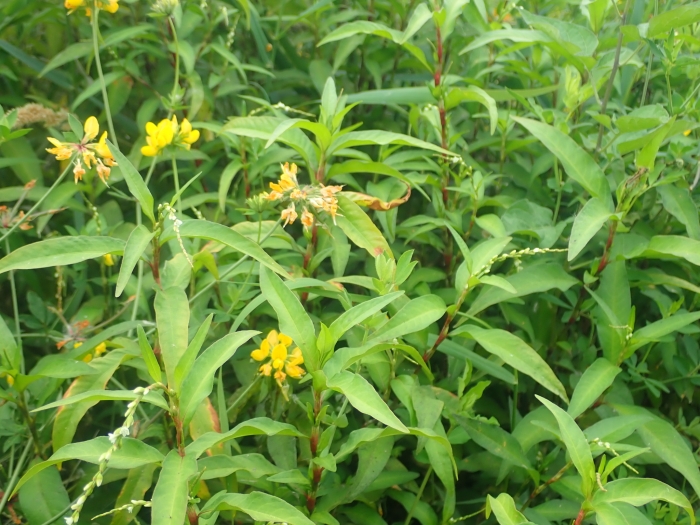Dotted Smartweed
(Persicaria punctata)
Dotted Smartweed (Persicaria punctata)
/
/

Nolan Exe
CC BY 4.0
Image By:
Nolan Exe
Recorded By:
Copyright:
CC BY 4.0
Copyright Notice:
Photo by: Nolan Exe | License Type: CC BY 4.0 | License URL: http://creativecommons.org/licenses/by/4.0/ | Rights Holder: Nolan Exe | Publisher: iNaturalist | Date Created: 2019-08-17T13:32:17-07:00 |



















































Estimated Native Range
Summary
Persicaria punctata, commonly known as dotted smartweed or dotted knotweed, is a highly variable plant that can be either annual or perennial. It is native to wetland areas such as marshes, swamps, and the edges of ponds and streams across North, Central, and South America. This species grows from a rhizome and produces decumbent or erect stems that can reach lengths slightly over one meter (40 inches). The leaves are lance-shaped with a pointed tip and are often marked with a dark spot. The inflorescence consists of branching clusters of small, dotted greenish flowers with white edges, sometimes tinged pink, which bloom in the summer and early fall. The flowers are not particularly showy but can add a subtle charm to water garden settings.
Dotted smartweed is appreciated for its ability to thrive in wet conditions and is often used in water gardens, rain gardens, and as a ground cover in damp areas. It is also valued for its wildlife benefits, as it provides food for waterfowl and other animals. In cultivation, it requires full sun to part shade and prefers medium to high amounts of water, thriving in soils with slow drainage. While it can be a vigorous grower, care should be taken where it is planted, as it can become invasive outside its native range. Gardeners should be aware of its potential to spread and should manage it accordingly to prevent unwanted naturalization.CC BY-SA 4.0
Dotted smartweed is appreciated for its ability to thrive in wet conditions and is often used in water gardens, rain gardens, and as a ground cover in damp areas. It is also valued for its wildlife benefits, as it provides food for waterfowl and other animals. In cultivation, it requires full sun to part shade and prefers medium to high amounts of water, thriving in soils with slow drainage. While it can be a vigorous grower, care should be taken where it is planted, as it can become invasive outside its native range. Gardeners should be aware of its potential to spread and should manage it accordingly to prevent unwanted naturalization.CC BY-SA 4.0
Plant Description
- Plant Type: Herb
- Height: 1-2.5 feet
- Width: 2-3 feet
- Growth Rate: Moderate
- Flower Color: White
- Flowering Season: Summer
- Leaf Retention: Deciduous
Growth Requirements
- Sun: Full Sun, Part Shade
- Water: Medium, High
- Drainage: Medium, Slow
Common Uses
Bee Garden, Bird Garden, Butterfly Garden, Low Maintenance, Water Garden
Natural Habitat
native to wetland areas such as marshes, swamps, and the edges of ponds and streams across North, Central, and South America
Other Names
Common Names: Dotted Knotweed, Dotted Water Smartweed, Water Smartweed, Renouée Ponctuée, Erva-De-Bicho-Pontuada
Scientific Names: , Polygonum punctatum, Persicaria punctata, Polygonum punctatum var. eciliatum, Polygonum acre, Polygonum punctatum var. punctatum, Polygonum punctatum var. aquatile, Polygonum epilobioides, Persicaria acre, Polygonum punctatum var. ellipticum
GBIF Accepted Name: Persicaria punctata (Elliott) Small